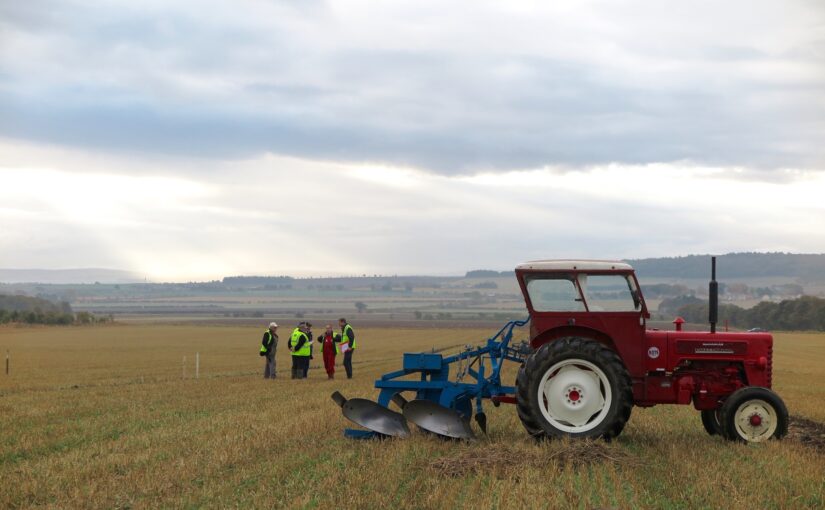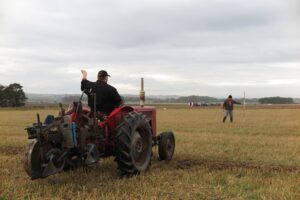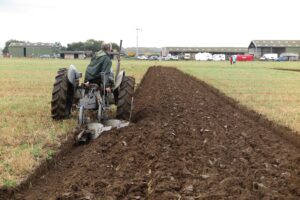The farmers in Stirlingshire were innovative for introducing new plough types into the district. They had been early adopters of the steam plough in the mid 1850s, though its use was short-lived and the plough went to Alloa a short time afterwards.
That keen-ness to introduce new ploughs continued in future decades. In 1879 the farmers held an early trial of the American chilled plough in the eastern district of the county. This was held under the auspices of the Eastern District of Stirlingshire Agricultural Association. It was reported in a number of the newspapers including the Falkirk herald of9 August 1879. Here is an account of that trial:
“Eastern District of Stirlingshire Agricultural Association
Trail of the American Patent Chilled Plough
An important trial of the American patent chilled plough-under the auspices of the Eastern District of Stirlingshire Agricultural Association – took place on Wednesday, on the farm of Bowhouse, in the Kerse of Falkirk. Among those present on the ground were Ralph Stark, Esq, vice-president of the association; Findlay Anderson, Esq, Inchyra Grange; Henry Band, Esq, Abbots Grange; Andrew Nicol, Esq, Beancross; Mr Wm Calder, Mumrills; Mr Graham Hardie, Little Kerse, &c &c. The gentlemen interested in the trial met in a field of fallow, kindly granted by Mr Learmonth, tenant of the farm-who also supplied the exhibitor, Mr Thomas Scott of South Woodend, Denny, with a powerful pair of geldings, of the best blood of the Clydesdale breed. The start was made at tow o’clock; and after two hours’ ploughing-the work done being very strictly scrutinised by a number of the directors of the society and others interested in the trial – there was out one opinion as to the superiority of the American invention over the Scotch iron plough. The new plough has the following advantages over the home implement; it is one-third lighter in draught – which of itself is a very great recommendation. It was admitted by competent judges, that it would have taken three horses to go over the same breadth and depth of furrow, as was done by the two who were in the plough yesterday; and in addition to this the work was much better done-the American implement turning over the fallow in beautiful style. One “point” of the new implement will plough one hundred acres; so that no blacksmith is required, while a young lad, or a field worker, can hold it. The depth is regulated by a wheel in front of the plough; and this, too, is a great recommendation. The plough is about one half lighter in itself than the Scotch implement, and when the skim coulter is put on – which is a most useful and simple appendage – all wild grass is ploughed down into the furrow. Stubble or loose straw is also gathered as the plough progresses, and is entirely buried out of sight. After the completion of the trial, Mr Learmonth kindly entertained the directors of the society at his hospitable fireside; and after some pleasant talk on the event of the day, Mr Stark rose and proposed “Success to the plough, and a safe journey to Mr Scott” – who was about to sail for America personally to inspect the works and to bring home a consignment of the new ploughs. In giving the toast, Mr Stark spoke of the very successful trial which had just been witnessed; and said that judging by what they had all seen that day, there could be but one opinion as to the complete success of the trial, and the great advantage of the American over the Scottish plough. The directors were quite agreed on the merits of the new invention; and he had no doubt that plenty of orders would be received by Mr Scott when the implement came to be better known. The toast was cordially received and acknowledged; and after spending sometime longer under Mr Learmonth’s hospitable roof, the party adjourned, all well pleased with the success of the trial.”
Mr Scott had entered “Oliver’s American chilled plough [of Oliver Plow Company, South Bend, Indiana], and some grindstones of approved make” to the Highland Show at Perth of July 1879. According to the North British Agriculturist of 16 July 1879 it had “beam and handles of American oak, and fitted with skim coulter, the main advantages claimed for the plough were lightness of draught, adaptability for loamy soil, and the facilities it affords for ploughing down wild grass, stubble, or loose straw.”
By 1881 Thomas Scott of South Woodend, Bonnybridge, described himself as an “American plough importer”. In 1885 he advertised himself as “sole importer for Great Britain and Ireland of Oliver’s American chilled plough. By 1886 he had opened up premises in Glasgow at 6 North Coburg Street. In 1889 he had moved to 17 Kirk Street. He exhibited at the Highland Shows between 1879 and 1889. He entered his imported ploughs at a number of trials of the Highland Show: the exhibition of ploughs in 1881, the trial of implement for autumn cultivation of stubbles in 1885 and trial of implement for spring cultivation of land in 1887.
He made an important contribution to changing the face of Scottish ploughs and ploughing in the 1880s.
The photos were taken at the Scottish Ploughing Championships, 2016.


